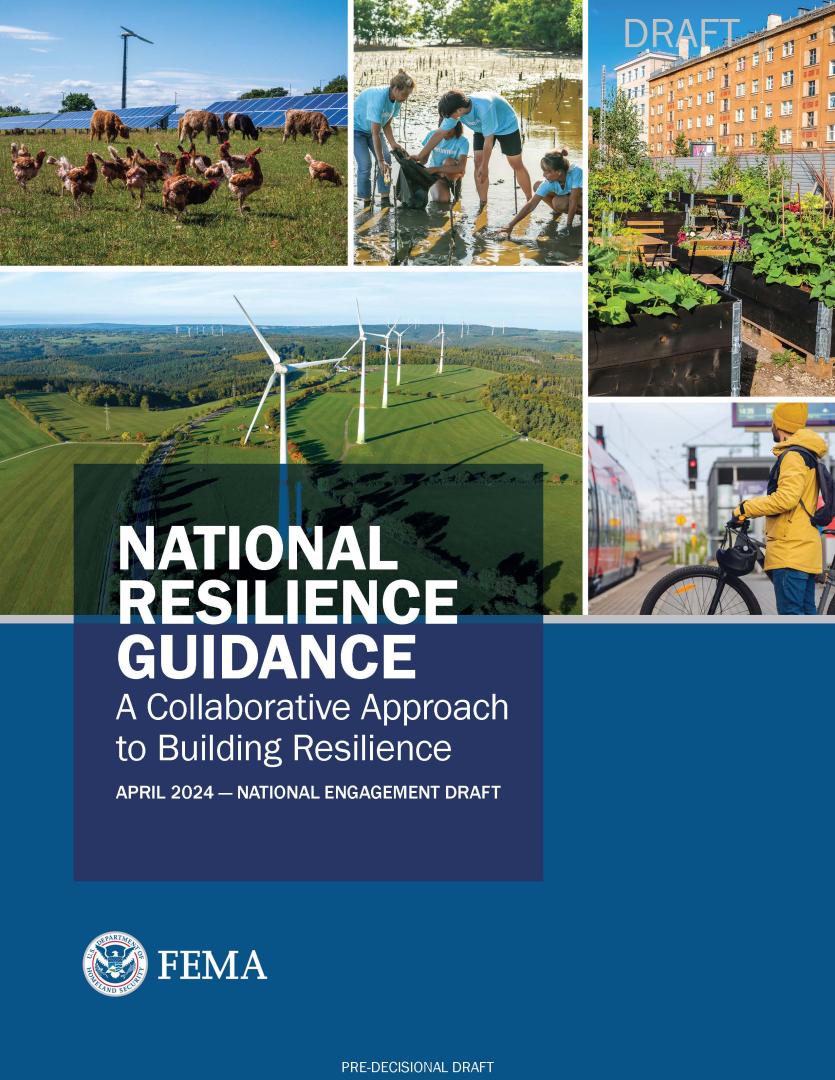Posted by Janet B. Stroud — May 3, 2024 — Each Earth Day, the nation comes together to recognize the need for continued commitment to building a safe and sustainable planet. Throughout April, the U.S. Department of Homeland Security’s (DHS) Federal Emergency Management Agency (FEMA) worked with partners across the nation to recognize the effects of a changing climate and how communities can build resilience to withstand the risk of today, and those anticipated in the future.
FEMA Administrator Deanne Criswell remarked:
We’re looking at a future defined by climate change, one that requires FEMA to lean harder into our role as resilience-builders. We’ve already seen a year of unprecedented weather events, and we need to use innovative solutions to tackle these problems today, to ensure a stronger nation tomorrow. And thanks to President Biden’s Investing in America Agenda, we have historic-level funding to ensure communities have the resources and tools they need to prepare for future disasters.
Throughout Earth Month, FEMA hosted activities supporting climate-change resilience, including webinars, open public comment periods on resilience-building guidance, and continued commitment to actions that protect our planet. These activities and resilience-building opportunities include:
Convening partners to share best practices:
- On April 3, Administrator Criswell opened the 2024 Partners in Emergency Preparedness Conference for Pacific Northwest emergency management, government, public and private sector professionals. Administrator Criswell pledged the agency’s support of their work to prepare their communities for the effects of climate-driven hazards and challenged participants to leverage partnerships to ensure the communities they serve get the help they need and deserve.
- On April 17, FEMA and the DHS Center for Faith-Based and Neighborhood Partnerships co-hosted a Multi-Faith Leader Climate Resilience Roundtable to address climate change and convene federal partners and faith-based organizations focused on climate resilience. The event provided a platform for sharing resources, including FEMA’s Guide to Expanding Mitigation: Making the Connection to Faith-Based Partners, and discussed opportunities for technical assistance for climate-related outreach and engagement.
Hosting events to help communities prepare for extreme heat and wildfires:
- FEMA’s #SummerReady Extreme Heat series, which began April 26, concludes May 21 with a hybrid in-person / virtual
 #SummerReady Extreme Heat summit hosted by FEMA Region 5 in Chicago. Building on the lessons learned from the 2023 Extreme Heat Summit, this two-day engagement will offer opportunities for discussion, networking and cross-collaboration between all levels of government and community partners.
#SummerReady Extreme Heat summit hosted by FEMA Region 5 in Chicago. Building on the lessons learned from the 2023 Extreme Heat Summit, this two-day engagement will offer opportunities for discussion, networking and cross-collaboration between all levels of government and community partners. - To help individuals and communities protect themselves from the risks and effects of wildfire smoke, FEMA hosted the first-ever Wildfire Smoke Resilience Summit on April 29. The summit was an opportunity to learn about resources, get information about funding and hear wildfire smoke best practices.
Building national resilience:
- On April 23, FEMA released the final Climate Adaptation Planning: Guidance for Emergency Managers. The guide helps emergency managers incorporate climate adaptation into emergency management planning.
 FEMA also released the new draft National Resilience Guidance for a 30-day public comment period. This new guidance highlights the interdependence required to build resilience including climate, ecosystem, social, economic, infrastructure, and disaster resilience.
FEMA also released the new draft National Resilience Guidance for a 30-day public comment period. This new guidance highlights the interdependence required to build resilience including climate, ecosystem, social, economic, infrastructure, and disaster resilience.
Training emergency managers on climate change:
- This fall, FEMA will offer a new Climate Adaptation and Mitigation Certificate Program through FEMA’s Emergency Management Institute. This certificate program will be an opportunity to gain the knowledge and skills needed to lead climate-resilient initiatives in their community on a schedule that suits their professional and personal needs.
Telling the story of resilience:
- To underscore the work FEMA and its partners do to build a nation more resilient to the threats of stronger and more frequent weather events, FEMA publishes case studies that spotlight the projects and ideas being used across the country to increase local capacity to prevent, mitigate against, respond to and recover from both natural and man-made threats.
Promoting resources for communities to combat climate change, funding net-zero energy projects:
- Furthering President Biden’s Investing in America agenda, FEMA’s Public Assistance Program Grants will now cover post-disaster infrastructure investments to critical community infrastructure including schools, hospitals and fire stations. Using technologies including solar power, heat pumps and efficient appliances can increase energy security and resilience.
- The agency is also funding net-zero energy projects for its Hazard Mitigation Grant Program (HMGP), HMGP Post-Fire and Pre-Disaster Mitigation program, while offering incentives through its Building Resilient Infrastructure and Communities (BRIC) annual grant program. FEMA also funds low-carbon construction materials for Public Assistance, HMGP and BRIC. These activities are enabled by the Inflation Reduction Act.
- All year long, FEMA’s Ready Campaign prepares communities for the increase in severe weather events by helping people understand the risk they face and outlining steps they can take to stay safe. This includes making a plan to protect themselves and their families, knowing the types of flood risk where they live, having trusted sources to receive warnings, and purchasing flood insurance.
Visit FEMA for more information on these activities and resources.




